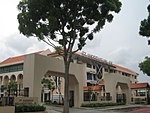Bidadari Cemetery
1908 establishments in Singapore1972 disestablishments in SingaporeCemeteries in SingaporeDemolished buildings and structures in SingaporeEngvarB from June 2018 ... and 1 more
Serangoon

Bidadari Cemetery (Malay: Perkuburan Bidadari, Chinese: 比达达利坟场) is a defunct cemetery in Singapore. It used to serve the Christian, Muslim, Hindu and Sinhalese communities, and accepted burials between 1907 and 1972. The site of Bidadari Cemetery used to be the Istana residence of one of Sultan Abu Bakar of Johor's wives. By 2006, all known graves were exhumed to make way for development of the Bidadari Estate.
Excerpt from the Wikipedia article Bidadari Cemetery (License: CC BY-SA 3.0, Authors, Images).Bidadari Cemetery
Bidadari Park Drive,
Geographical coordinates (GPS) Address Nearby Places Show on map
Geographical coordinates (GPS)
| Latitude | Longitude |
|---|---|
| N 1.335425 ° | E 103.87200277778 ° |
Address
Blk 107A
Bidadari Park Drive
340106 , Toa Payoh
Singapore
Open on Google Maps







